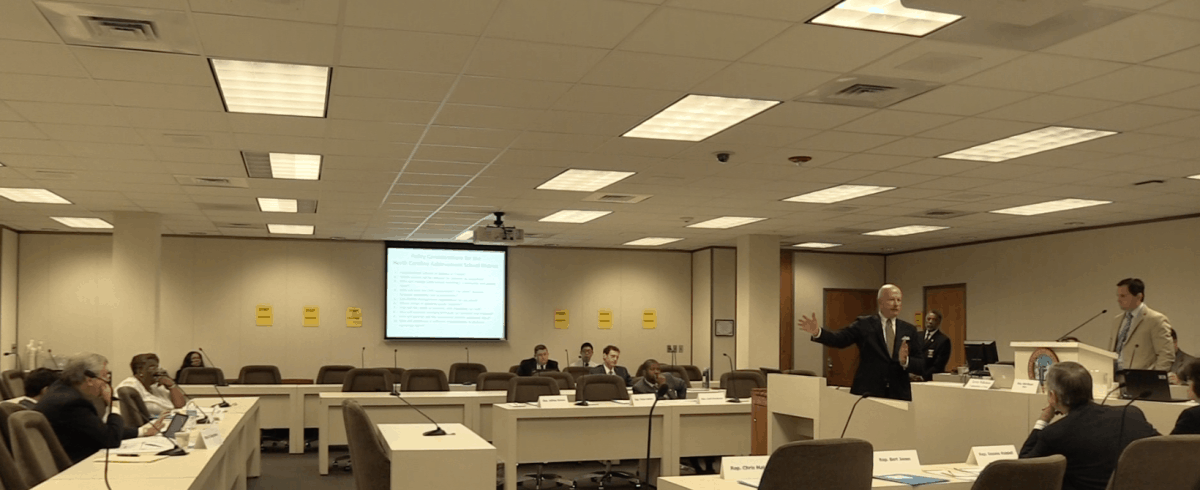A legislative committee met yesterday to continue considering a controversial proposal to create an Achievement School District (ASD) in North Carolina.
Under the draft bill language, up to five of the state’s lowest-performing schools would be removed from their districts and placed under the governance of the ASD, a new, statewide “district” that would oversee the selection of nonprofit or for-profit charter management organizations to operate the schools.
North Carolina would not be the first state to try the recovery district approach, with high-profile efforts in New Orleans, Tennessee, and Michigan. At yesterday’s committee meeting, Vanderbilt University professor Dr. Gary T. Henry detailed Tennessee’s ASD and how it has affected student achievement, discussing a policy brief he and his colleagues released in December, Evaluation of the Effect of Tennessee’s Achievement School District on Student Test Scores. Dr. Henry previously delivered a similar presentation to the Public School Forum’s Study Group on Educational Opportunity at the North Carolina Museum of Natural Sciences on January 28.
The researchers found that, overall, schools in the ASD did not fare better or worse than other low-performing Tennessee schools identified for intervention.
In their policy brief, Dr. Henry and his colleagues also spotlighted Tennessee’s other efforts to turn around low-performing schools, which received a boost in 2010 from a $500 million Race to the Top grant. Tennessee took a portfolio approach: struggling schools were either placed in the ASD or required to undergo one of three alternative “turnaround” interventions: 1) a district-led Innovation Zone (or “iZone”), 2) one of the federal School Improvement Grant (SIG) plans, or 3) a district-led school improvement planning process.
In an iZone, an office is created within an existing district to run a subset of the district’s lowest performing schools. They have the same local school board and superintendent, but the iZone follows a different set of rules, allowing for more flexibility. In Tennessee, iZone schools receive funding assistance and are able to restructure budgets to use resources differently and pay teachers more. They are also better able to shift their schedules, craft new teaching roles, and make school-level curricular choices.
The results in Tennessee? Dr. Henry and his colleagues found that “iZone schools are having a positive, statistically significant, and substantively meaningful effect on student achievement across all subjects,” unlike any other turnaround approach, including ASD. The researchers found that the district-led iZone schools showed moderate to large positive effects in math, reading, and science, with strong, consistent effects across subjects for the iZone schools in Memphis.
The newest version of North Carolina’s ASD legislation, released yesterday, includes an option for districts that transfer schools to the ASD to create iZones for up to three of their continually low-performing schools.
Race to the Top–the same federal education program that led to the creation of the ASD and iZones in Tennessee–also funded a large initiative in North Carolina, called Turning Around the Lowest Achieving Schools (TALAS). Our lowest achieving schools (in the bottom 5 percent) qualified, including 65 elementary schools, 24 middle schools, and 20 high schools. In his January 28 Public School Forum Study Group presentation, Dr. Henry discussed his ongoing research into the impacts of the TALAS initiative on student achievement in North Carolina.
TALAS and Tennessee’s iZones differ in their structures but support similar conclusions about what matters most in turning around low-achieving schools. Chief among these is that recruiting and retaining great teachers and leaders needs to be a significant part of any state’s long-term turnaround strategy, whatever the governance approach. In North Carolina, there are more teachers in their first year of teaching than there are at any other experiential level, and turnover rates continue to trend upward. In TALAS schools, however, North Carolina has seen a 10 percent lower rate of teachers leaving the profession. Likewise, in Tennessee, which has had to address similar teacher and school leadership pipeline crises, the flexibility to alter schedules, manage curricular decisions, and pay higher salaries has been credited with helping iZone schools attract and retain great teachers and leaders.
Drawing on his research in North Carolina and Tennessee, Dr. Henry offered nine “policy considerations” for state lawmakers to consider as they continue evaluating the promise and potential shortcomings of bringing an ASD to North Carolina.
Most of these will be equally applicable whatever turnaround approach the state pursues–an Achievement School District, Innovation Zones, or support for other state or district-led efforts to turn around the state’s lowest-achieving schools.
Recommended reading





